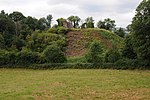Whitney-on-Wye railway station
Disused railway stations in HerefordshireFormer Midland Railway stationsPages with no open date in Infobox stationRailway stations in Great Britain closed in 1962Railway stations in Great Britain opened in 1864 ... and 2 more
Use British English from November 2022West Midlands (region) railway station stubs
Whitney-on-Wye railway station was a station in Whitney-on-Wye, Herefordshire, England. The station was opened in 1864 and closed in 1962.
Excerpt from the Wikipedia article Whitney-on-Wye railway station (License: CC BY-SA 3.0, Authors).Whitney-on-Wye railway station
A438,
Geographical coordinates (GPS) Address Nearby Places Show on map
Geographical coordinates (GPS)
| Latitude | Longitude |
|---|---|
| N 52.1218 ° | E -3.0763 ° |
Address
Whitney-on-Wye (Whitney)
A438
HR3 6EZ
England, United Kingdom
Open on Google Maps



